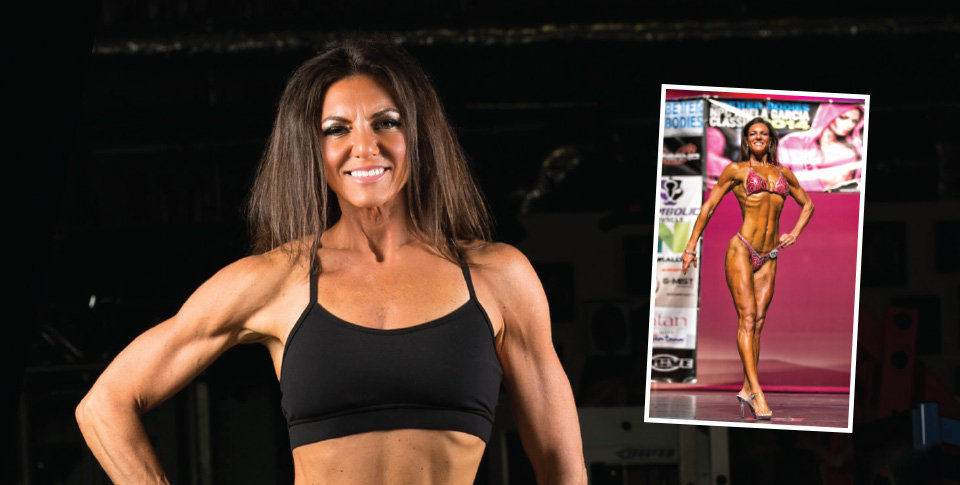My Life as a Diabetic Figure Competitor

I was 29 and pregnant with my first son when I was diagnosed with gestational diabetes in 2000. After delivery, my condition persisted and I had to learn how to live with Type 1 insulin-dependent diabetes. Fifteen years later, and today I have competed in and won multiple figure competitions and now work to promote fitness as a tool to help other people manage their diabetes.
Growing up in New Jersey, as a kid I was always active in sports—from swimming, basketball, and gymnastics to tennis, bike riding, and boxing. But I never stopped dreaming of competing in fitness and figure competitions. In 2008—when I first started training for competitions—I had a set diet with which I ate the same foods at the same time every day, with a set insulin-to-carbohydrate ratio for each meal. My first figure competition was held at the New York Metropolitan in New York City in April 2008 and I competed in my second figure competition in Pennsylvania in May 2008. I placed 2nd overall in both shows.
When I moved to Texas later that year, my then 4-year-old daughter Molly was also diagnosed with Type 1 diabetes. Now 11 years old, she is fully independent with caring for herself and using the Medtronic pump. We often exercise alongside each other—doing fun runs like the Schlotzskys’ Bun Run, where all proceeds support the Juvenille Diabetes Research Fund.
When I unexpectedly got divorced shortly after moving to Austin, I gained a lot of weight and temporarily lost interest in the rigors of competing. It was still a dream of mine though, as it had been for awhile, so in 2013 I decided to recommit myself to attaining peak physical fitness. My goal: to compete in the Texas Shredder Classic—a figure competition held in Austin—in April 2014.
My preparation for competitions is a careful balance of training, diet, blood sugar checks, insulin shots, and keeping close contact with my endocrinologist—who I would see once every few weeks. Making sure my feet were well taken care of, my heart rate status was known, and that I was able to safely train at an intense level was also part of preparation.
Diet is also vital in the equation to become fit and it’s something to seriously consider before you start training and competing. Most people are surprised to learn that diet is 70 percent exercise and that the food intake and restriction component is the most difficult part—even more so as a diabetic. As though that isn’t enough of a challenge, I’m also a vegetarian. My staple foods are oatmeal, blueberries, brown rice, and sweet potatoes for carbohydrates; egg whites, grilled white fish, and salmon for protein; and avocado and natural almonds for fat intake. My meals are spaced out in 3-hour increments and I never miss one. I eat at the same times every day and my lunch bag follows me everywhere.
My meals are all measured and weighed with portion control and carbohydrate counting to help keep my blood sugars regulated, and I make sure to always eat and check my blood sugar before and after every workout. If the number is high, I correct it before every meal and count my carbs based on my insulin-to-carb ratio. If the number is low, I take a carbohydrate out of a meal and use that to increase my blood sugar so it's not affecting my training diet.
My training regimen is just as rigorous. I do legs twice a week, arms twice a week—working different muscle groups each day—and do cardio and high intensity interval training four times a week. In the off-season, I put on 10 pounds to increase my body fat by 5 percent and help build muscle. The key to competing is having size, being lean in your body fat—around 6–8 percent—and hydrating your muscles with a gallon of water a day. During competition, my body fat is at 6 percent, but it fluctuates from 11–13 percent in the off-season. That’s not to say I stop eating well and training hard in the offseason. To the contrary, I am consistently training and never miss a work out.
That goal I set to compete in the Texas Shredder Classic in 2014? I met it and went on to compete in the Adele Garcia Classic in Hutto and the Europa Games in Dallas—where I placed fourth.
With all the changes that occured in my life in a span of 6 years, competing the second time around in 2014 was much more difficult than when I first took the stage in 2008. But it reignited a fire within, and reminded me of the person I have always been—a fighter.
Alissa plans to compete again in 2015 and currently works as a therapist, fitness model, and fitness/diabetes advocate in Austin. Keep up with her at fitalissa.com.






